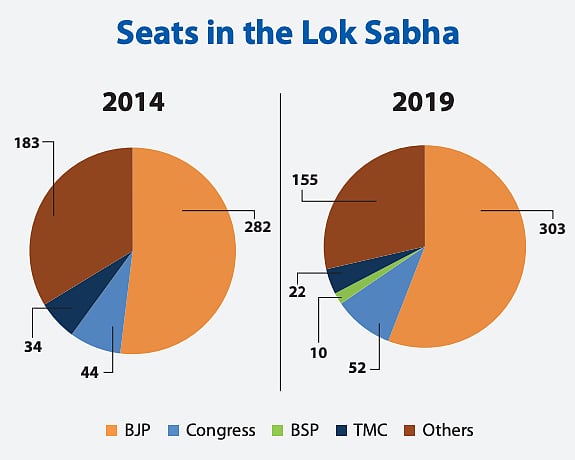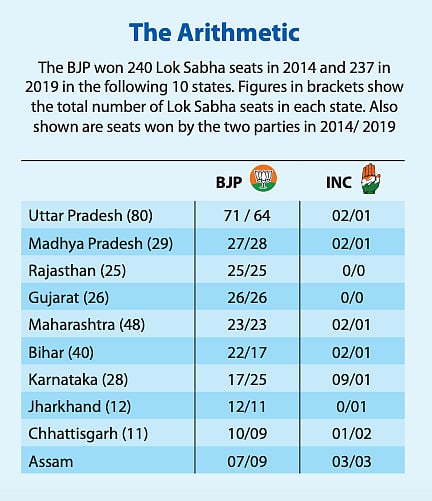Lok Sabha 2024: Taking the battle to the BJP
For the Opposition, a winning strategy may have to pivot on tactical alliances to avoid a split in the anti-BJP vote

In a ‘proportional representation’ universe, instead of the firstpast-the-post electoral system India follows, the BJP, which secured 37.7 per cent of the valid votes in 2019, would have 206 members in the Lok Sabha; it has 303. With less than 38 per cent of the votes, the BJP cornered 55 per cent of the seats. The Congress, which polled 19.7 per cent of the votes—in what seemed like a rout—would’ve had 106 members, not 52. With nearly 20 per cent of the popular vote, the Congress ended up with less than 10 per cent seats. The point here is not to quibble with the electoral system—it is what it is—but to focus on an alternative reality. We are liable to forget that its brute majority in the current Lok Sabha is not a true measure of the BJP’s national vote base.
For all the optimism it always affects, the BJP is acutely aware of this fact. It also realises that it has too many enemies—and not many friends any more among its supposed allies. The use-and-throw tactics it has employed with former allies like the Shiv Sena and the JD-U are now an open secret. That shared dislike of the BJP is perhaps the strongest glue for a still disparate Opposition. Whether that glue can successfully bind them in a strategic alliance before Lok Sabha 2024 is not yet clear, but there are very clear signs of hope in the Opposition camp and a certain unease in the BJP that 2024, which they thought was in the bag, looks open again.
‘2024 is no longer a done deal for the BJP,’ wrote Yogendra Yadav in The Print, soon after the coup in Bihar, when Nitish Kumar dumped the BJP—before they could dump him—to form a government with Tejashwi Yadav’s RJD, the Left and the Congress. Yadav argues that even with its current dominance, the BJP will find it hard to win more than 243 seats in 2024. With the BJP no longer secure in Bihar and Maharashtra, and the Congress showing some signs of a revival, the possibilities for 2024 are wide open again, says Yadav.
If the Opposition gets together, said Nitish Kumar to his party workers in Patna, the BJP will be reduced to 50 seats. That’s hyperbole, of course, but if the Opposition can work out a strategy, potentially a state-wise plan, to prevent a split in the anti-BJP vote, the saffron party will have a real battle on its hands. The BJP is not counting on retaining all the seats it won in 2019; it gave away some of that nervousness in its declared intention to focus on the 144 seats it lost in 2019, particularly in Andhra Pradesh, Telangana and Odisha.
Wherever it is not certain of a decisive victory, the BJP will try to split the anti-BJP vote—by engineering triangular or four-cornered contests; winning over smaller parties and/or encouraging them to field candidates and propping up Independents. With its stranglehold of mainstream media, it will ensure a steady poison drip of doubt about the Opposition’s ability to unite and deliver a strong decisive government. As in the past, the narrative will once again be that everyone has ganged up against the BJP and Prime Minister Modi.


A question Opposition leaders will repeatedly be asked, via the media, is to name a prime ministerial candidate. It may be instructive to recall that the Opposition did not have a prime ministerial face in 1977 or 1991 or 1996 or 2004. Before Modi in 2014, and barring Vajpayee in 1999 and 2004, the BJP too didn’t project a PM candidate, but those facts will not be allowed to interfere with a narrative that serves the BJP’s purpose. The Opposition, on its part, will have to learn to sidestep the question convincingly and focus instead on a tactical understanding, on perhaps a shared manifesto, on a governance agenda and maybe even a common minimum programme. Some opposition parties have state-level rivalries, and “it won’t be easy to set up twoway contests against the BJP, but it’s been done before,” says political commentator Arun Sinha.
Then there are regional parties with national ambitions. K. Chandrasekhar Rao of the Telangana Rashtra Samithi (TRS) has been trying to forge yet another ‘third front’; Nitish has tried to gently dissuade him, but it’s hard to tell if KCR can be persuaded to yoke his fortunes to the combined Opposition’s. There will be no third front, only a main front, Nitish has said, also clarifying for the benefit of leaders like KCR and Mamata Banerjee of the TMC that the Congress will be a key factor in the Opposition front. Another outlier in the opposition ranks is the Aam Aadmi Party (AAP), chasing its own dream of going national.
But these regional parties are also wary of the BJP and its cannibalising ways. Over the past eight years, they have all been at the receiving end of an alarming centralisation of power at the cost of the states. They have witnessed a steady erosion of their federal rights; delays and outright rejection of GST compensation payments; the Centre’s legislative overreach in matters on the state and concurrent lists… the list of complaints is long, and the reasons to want the BJP out of power very compelling, but we’ll have to wait and see if the personal ambitions of these satraps trump their sense of a shared destiny.
Barely ten days before Nitish Kumar pulled the plug on the BJPJD(U) government in Bihar, BJP president JP Nadda declared in Patna that the days of regional parties were numbered. He was suggesting perhaps that the BJP would no longer need the National Democratic Alliance (NDA), which, at one point, had 18 constituents. For parties like the Shiv Sena in Maharashtra, the JD(U) and the LJP in Bihar and the Shiromani Akali Dal in Punjab, that association with the BJP turned out to be the proverbial kiss of death.
A whole host of factors still favour the BJP. In power for the past eight years, it has completely re-written the rules of the game. It has denied the Opposition a level playing field, built a humongous war chest with electoral bonds and has turned the Election Commission of India into a pliant submissive partner in its plans. It also has other cards up its sleeve.
Ram Mandir in Ayodhya. The installation of the idol of Ram Lalla at Ayodhya has been pushed back to early 2024, ahead of the general election. The BJP will spare no effort to use the event to drum up religious fervour, and deflect attention from pressing everyday issues like the price rise or the lack of jobs or the government’s economic and political mismanagement, or the lack of social security, and the brazen violations of human rights.
Modi’s last election? Narendra Modi will be 73 in 2024. So, when BJP asks voters to rally round the Prime Minister and give him another term to complete his unfinished mission, how will the Opposition respond? The emotional card to vote for him in possibly his last election nay be hard to counter.
Nationalism. Another failsafe weapon in its electoral arsenal, the BJP is able to crank out the nationalism narrative at will. Recall the Pulwama terror attack and the retaliatory airstrike on Balakot in Pakistan before Lok Sabha 2019.
Welfarism. The BJP's success on this front, says Arun Sinha, is not in providing better welfare schemes to the people but in politically encashing them. “The RSS-BJP workers fan out to brainwash beneficiaries about Modiji’s largesse, to make sure that the schemes convert into votes.” Unless the Opposition can call this bluff and convince people that the schemes are paid for from the public exchequer and not any party or private fund, the BJP’s welfare plank will also be hard to dislodge.
The concerted ED (Enforcement Directorate) raids on opposition leaders are yet another thing to contend with. Quite apart from putting them on the defensive, the raids also build an adverse public perception about these leaders. The TV channels are only too happy to play their part in fanning this narrative, sidestepping anything that might reflect poorly on the government. So, nothing for example about allegations of 40 per cent commission demanded for government contracts in Karnataka or job scams in Uttarakhand or a midday meal scam in Madhya Pradesh, to cite just a few instances of corruption and misgovernance in BJP-ruled states that fail to make the headlines. The Opposition will have to find new ways of amplifying misrule under the BJP.
The Bharat Jodo Yatra is one such idea. In just over a week at the time of writing this piece, it was already making an impact. The kind of mass connect it has made possible, the quietly determined resistance it seems to be making space for, the voice it has given a seething popular resentment against the BJP government and its divisive politics are a hopeful sign. But this is still south India. The southern states have traditionally been suspicious of the BJP and supportive of the Congress. The suspicion has only grown with the planned delimitation of constituencies on the basis of population, which will add many more Lok Sabha seats in Uttar Pradesh and Bihar at the cost of the South. At stake in the five southern states are 129 Lok Sabha seats, which can tilt the scales in unforeseen ways.
Follow us on: Facebook, Twitter, Google News, Instagram
Join our official telegram channel (@nationalherald) and stay updated with the latest headlines
